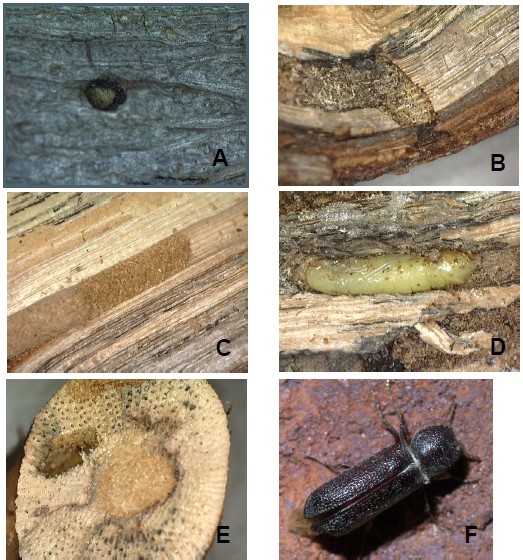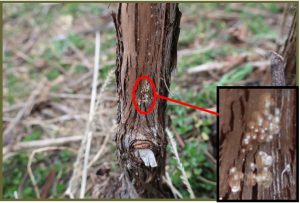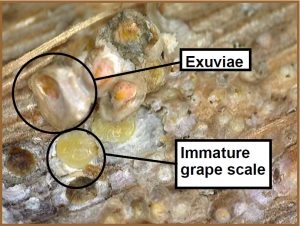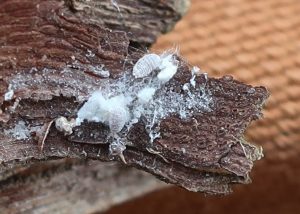Published on
Updated on
Contents:
Keep Alert For Potential Grape Pests When Pruning
“The hand is quicker than the eye.” This likely holds true when dormant grape pruning is behind schedule and the weather warms and sap flows. During these times, the pruning shear seems to have a mind of its own as canes drop to the ground in rhythmic motion. But as we all know, the eye is quicker than the hand and so keep your eyes focused not only on the placement of pruning cuts, but also me mindful of pests that may be lurking on or just under the bark of those fallen canes, old spurs, or cordons.
Please share these pictures with your pruning colleagues. Making them aware of the signs of potential insect pests while pruning. Here are a few things I have found in the past two weeks.
Grape Cane Borer Amphicerus Bicaudatus

A) Entry hole in a grape cane by a larva of the grape can borer (Amphicerus bicaudatus). B) Longitudinal cross-section of a grape cane showing the entry hole and tunnel of the grape cane borer larva. C) Longitudinal cross-section showing tunneling in the pith of the grape cane and frass. D) Longitudinal cross section of a grape cane showing a pupa of the grape-cane borer. E) Cross-section of a grape cane showing tunneling by the grape cane borer. F) Grape cane borer adult beetle. Photo credit: A–E: D. S. Volenberg; F: Bob Webster BugGuide 2014.
The grape cane borer is often identified by the symptoms observed within the vineyard. A larva may spend up to a year in the grapevine cane completely concealed. The only evidence being an entry hole typically found near node (Figure 1A). When removing canes during dormant pruning, you may see a tunnel or hole in the cross-section of the remaining spur (Figure 2E). A longitudinal cut along a cane in which an entry hole was observed will show tunneling, frass that appears as sawdust and potentially an adult, pupae, or larvae depending on the time of the year observed. Tunnelling of the grape can borer can be found within the pith of the cane (Figure 1C).
Sanitation is the key to managing the grape cane borer. Pruning’s should be removed from the vineyard and destroyed. Since the grape cane borer spends the most of its life cycle within the cane, insecticides are only effective if adult beetles are observed throughout the vineyard (Figure 1F). Long-term management of the grape cane borer is sanitation (removal of old cane material from the vineyard and burning the canes) and exclusion (removal of nearby hosts). The grape can borer has a wide host range that includes; pecan, peach, plum, apricot, ash, butternut, hickory, maple, and apple trees. Often abandoned orchards are a major source of the grape cane borer.
The grape cane borer is a sporadic pest. In 1888, The Kansas State Agricultural Collage Experiment Station, Manhattan, KS reported severe outbreaks in both apple and grapes. More recently, Feb. 28, 2020, vine damage and grape cane borers were identified in vineyards in Willamette Valley, Oregon.
Selected References
- BugGuide. Amphicerus Bicaudatus — Apple Twig Borer.
- Marlatt, C.L. The Principal Insect Enemies of the Grape.
- Yearbook of the U.S. Department of Agriculture.
- Mulder, P. 2019. Grape Cane Borer/Apple Twig Borer Amphicerus Bicaudatus.
- Popenoe, E. A. 1888. Observations of Two Insect Pests. Kansas State Agricultural College, Manhattan, KS. Bulletin No. 3.
- Skinkis, P. and V. Walton. 2020. Pest Alert: Grape Cane Borer
Grape Scale Diaspidiotus Uvae

The grape scale has been in Missouri for almost 150 years. In fact, the first recorded specimen of grape scale in the U.S. was from St. Louis in 1875.
Determine if Grape Scale Is Present
Grape scale typically are not easy to see since the majority of their life cycle takes place under the bark of the grapevine. Stripping bark away allows one to determine the presence or absence of grape scale (Figure 2). If grape scales are present, they are readily visible to the naked eye (Figure 2).
At this time of year, grape scales are immature and are overwintering under the bark of grape trunks and cordons. Removal of the scale will reveal the immature form of the grape scale (Figure 3). The first generation of crawlers will emerge from maternal scales in May. The crawlers will move about the vine for a short duration (24 to 48 hours) before selecting a feeding site. Female scales never move from their feeding site, whereas male scales have wings and will search out females for mating. Grape scale crawlers are targeted for control measures.

Although grape scale has at times been destructive, typically many parasitic insects attack grape scale keeping grape scale populations controlled. However, if grape scale populations increase over time, it is common to observe vine decline and death. If grape scale populations are increasing within a vineyard block, then chemical management options should be considered.
Management
Prior to bud break, apply Superior oil to grapevine trunks and cordons. When applying Superior oil, be sure to saturate the trunk and cordons. This will result in the spray mixture running into voids and crevices under the bark where the grape scales reside. Superior oil spray solution must come in contact with the grape scale to be effective. All dormant oils cause lethality by depriving the insect pest of oxygen and by disrupting cellular membranes. Dormant oil sprays help preserve many of the beneficial insects since the application timing is prior to many of the beneficial insects emergence.
Lorsban Advanced can be applied to control crawlers. Spray application timing is the most important issue in controlling grape scale crawlers. To make sure your spray application is made at the correct time, monitor degree days and also monitor for grape scale crawlers in the vineyard. First generation crawlers emerge at 274 degree days (DD) at base 50°F starting on April 1. The peak emergence of first generation crawlers is at 356 DD (base 50°F). The second generation of crawlers begins emergence at 1,166 DD (base 50°F) and peak emergence of second generation crawlers is at 1,549 DD (base 50°F). The emergence of crawlers was documented by Don Johnson in Arkansas (see the reference below). An application of Lorsban Advanced will provide at least thirty days of lethal residual to control grape scale crawlers. Johnson also found that carbaryl (Sevin XLR) is effective in controlling the crawlers.
In addition to monitoring DD for crawler emergence, simple traps should be established on grapevines identified to be harboring grape scale. Double-sided tape is applied encircling the trunk and cordon. Once crawlers emerge they begin traveling along the trunk and cordon and will become trapped on the sticky tape. Monitoring these traps weekly as the DD approach 274 will allow you to pinpoint the time of crawler emergence.
Selected References
- Grape Scale Diaspidiotus Uvae (Comstock) Virginia Fruit Entomology
- Johnson, D.T., B.A. Lewis, and J.D. Whitehead. 1999. Grape Scale (Homoptera: Diaspididae) Biology and Management on Grapes. J. Etomol.Sci. 34:161-170.
- Zimmer, J. F. The Grape Scale. Aspidiotus [Diaspidiotus] Uvae Comst
Grape Mealybug Pseudococcus Maritimus
Determine if Mealybugs Are Present

Similar to the grape scale, the grape mealybug also remains mostly out of sight. Preferring to remain hidden under the grape bark (Figure 4). You may come across telltale signs of the presence of the grape mealybug as you strip bark away looking for the grape scale.
Lorsban Advanced applied at the delayed dormant stage through bud swell will control grape mealybugs.
Starting in 2020, Dr. Jacob Corcoran — a Research Molecular Biologist with USDA-ARS, Biological Control of Insects Research Unit here in Columbia — started research on mealybugs in vineyards. Jacob recently provided a very informative presentation on mealybugs during the Show Me Grape and Wine Conference.
Free Monitoring Program For Mealybugs
Dr. Corcoran is establishing a mealybug monitoring program in Missouri Vineyards starting in April 2021. Pheromone traps will be supplied without any cost. A single pheromone trap covers up to 30 acres. If you would like to participate in the mealybug monitoring program please contact Jacob.Corcoran@usda.gov.